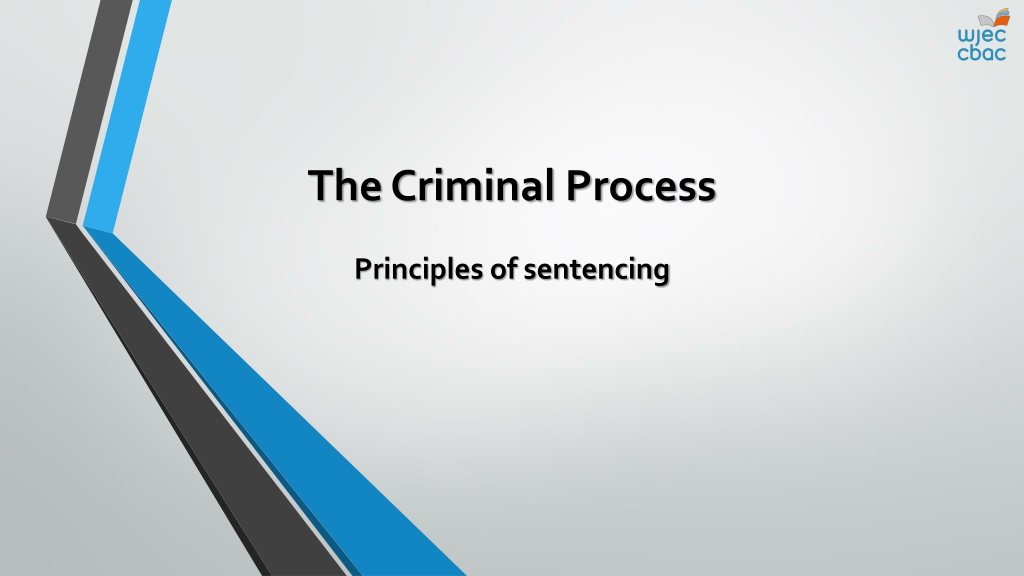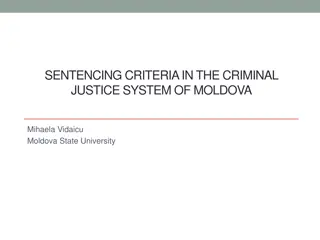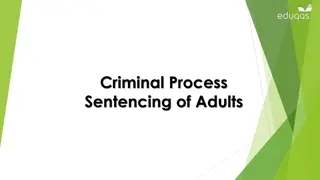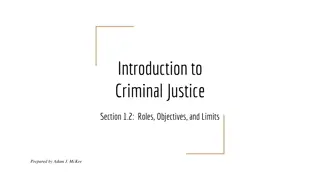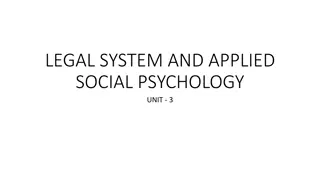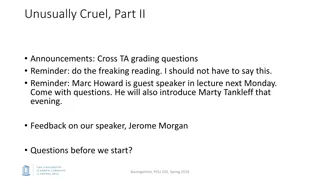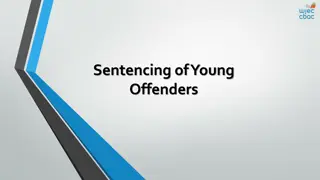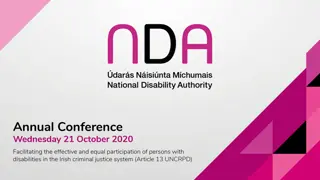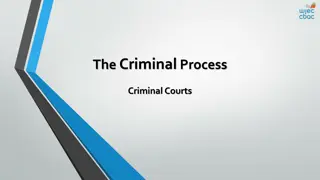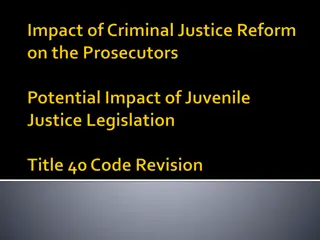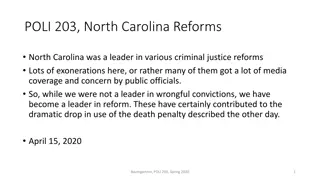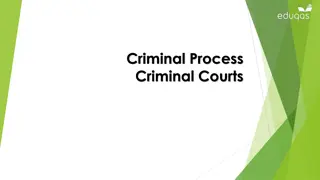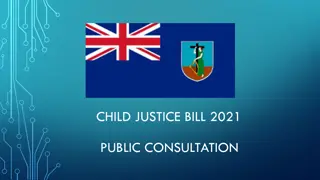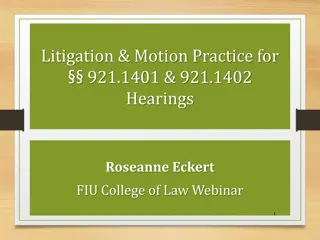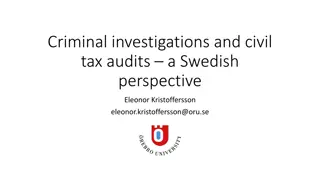Understanding Sentencing in the Criminal Justice System
Exploring the complexities of sentencing in the criminal justice system, this content delves into the principles of sentencing, the role of courts in determining sentences, restrictions on sentencing by magistrates and judges, maximum and minimum sentences, and the aims and effectiveness of the sentencing system.
Download Presentation

Please find below an Image/Link to download the presentation.
The content on the website is provided AS IS for your information and personal use only. It may not be sold, licensed, or shared on other websites without obtaining consent from the author. Download presentation by click this link. If you encounter any issues during the download, it is possible that the publisher has removed the file from their server.
E N D
Presentation Transcript
The Criminal Process Principles of sentencing
Sentencing Discussion Points What do you think sentencing is? Why do we have to sentence people? Who should decide the sentence and do you think there should be any restrictions on their power to sentence?
Sentencing Once an accused is convicted of an offence, it is the Court s job to decide what sentence will be given Magistrate or Judge depending on what Court the case is heard in There are a number of restrictions and factors that will be taken into account when deciding the appropriate sentence.
Restrictions on Sentencing Magistrates: Max 6 months imprisonment for a single offence Unlimited fine for serious offences: https://www.gov.uk/government/news/unlimited-fines-for-serious-offences Crown Court Judges Max life sentence Unlimited fines.
Maximum Sentences Magistrates and Judges are restricted by maximum sentences that are laid down by Parliament in the statute covering each offence. e.g. the maximum sentence for theft is 7 years, the maximum sentence for rape is a discretionary life sentence. Murder has a mandatory life sentence so is quite unique.
Minimum Sentences The Crime (Sentences) Act 1997 introduced minimum sentences for both persistent offenders, drug dealers and burglars The Act also introduced an automatic life sentence for offenders convicted of a second serious or violent offence.
SENTENCING As we explore sentencing in more detail, you will see that it is not an easy or simple process First of all we need to look at the aims of sentencing what is the criminal justice system trying to achieve by sentencing those who break the law Then we will go on to have a look at the powers that are given to the courts and what type of sentences they can give Comment as you go through as to how effective or otherwise you think the system is.
SENTENCING Before sentencing those who have been convicted of a criminal offence, the Magistrates or the Judge have to consider a range of different factors regarding the offence and the offender Often a pre-sentence report will be prepared by the Probation Service that will help with the decision to impose the most appropriate sentence for this particular offender.
Factors surrounding the Offence The main issue that will be considered here is how serious the offence is for the type of offence it is s 143(1) Criminal Justice Act 2003 In considering the seriousness of the offence, the court must consider the offender s culpability in committing the offence and any harm which the offence caused, or was intended to cause or might reasonably foreseeably have caused . Sentencing
Factors surrounding the Offence CJA 2003 states that other factors that should be considered are: Previous convictions for other similar offences or ones which are relevant to the current offence Whether the defendant was on bail when the offence was committed Whether there was any religious or racial element to the offence Whether there was any hostility to disability or sexual orientation involved in the offence.
Factors surrounding the Offence Other points the courts will want to know may include .. In a case of theft, how much was stolen, and was the defendant in a position of trust? In a case of assault what injuries were inflicted and whether the assault was premeditated; was the victim particularly vulnerable .? Where several defendants are convicted of committing a crime jointly, the court will want to know if any of them played a greater part than others, and who was involved in planning it. (The English Legal System, Jacqueline Martin). Consider the above extract. Why do you think these aspects are taken into account? Why should these factors affect the length of the sentence given?
Effect of a Guilty Plea If a defendant pleads guilty, the sentence is likely to be reduced The general rule is that the earlier the guilty plea is entered, the more time will be deducted from the sentence If a defendant pleads guilty at their first opportunity to do so, up to one third will be deducted from their sentence Pleaded guilty once the trial has started will receive up to one tenth discount Discounts are calculated on a sliding scale.
Effect of a Guilty Plea Discussion Points: Why do you think the sliding scale for discounts to sentences for guilty pleas is in operation? Do you think it can be justified? What are the problems with this system?
Affect of a Guilty Plea Sentencing Council justifies the discount system as follows: A reduction in sentence is appropriate because a guilty plea avoids the need for a trial, shortens the gap between charge and sentence, saves considerable cost, and, in the case of an early plea, saves victims and witnesses from the concern about having to give evidence .
Affect of Guilty Pleas As you can see, the discount system for early guilty pleas can be very controversial. As a result, the Government introduced changes to the system. Use the internet to find out what these changes were.
The Offenders Background Factors the Court will consider here include: Any previous convictions, including reaction to previous sentences, whether he was on bail Where there is the possibility of community sentences a pre-sentence report will be prepared by the Probation Service with details of the offender s background and suitability for this type of sentence If there are any medical or psychiatric issues involved in the offence the Court will ask for a medical report before making their decision If imposing a fine, the financial situation of the offender will need to be fully disclosed.
Sentencing Guidelines Used to be set by the Court of Appeal but they had to wait for a suitable case to come to court. Sentencing Advisory Panel was set up in 1998 to advise the Court of Appeal on guidelines. Sentencing Guidelines Council was set up following the Criminal Justice Act 2003. Now all combined in the Sentencing Council.
Sentencing Council TASK In small groups, conduct some research into the Sentencing Council. Find out what it does, how it makes decisions, what impact it has had on areas of sentencing practice, what projects it is currently working on, etc. Prepare a presentation that lasts no more than 10 minutes to give to the whole group. You must all take part in the presentation. Visit:http://sentencingcouncil.judiciary.gov.ukand explore some of the guidelines that they have issued.
Types of Sentence A sentence is the punishment given to the defendant when they are convicted, and the type of sentence can vary depending on whether the defendant is an adult or youth offender. The sentence that can be given to an offender depends on the Government of the time and their priorities which are often affected by current events and media pressure. Both adult and youth offenders can receive the same type of sentence, but they vary in terms of their requirements and their length. The judge is responsible for sentencing in the Crown Court and the magistrates is responsible in the Magistrates Court. The range of sentences available to each court does vary:
Types of Sentence Court Sentence Unlimited fine Magistrates 6 months imprisonment Unlimited fine Crown Life Imprisonment
Sentencing Thetariff, or length of the sentence will be determined by the court following guidelines issued by the Sentencing Council. The court will look at the following factors: The age of the offender The seriousness of the offence The likelihood of further offences being committed The extent of harm likely to result from further offences. There are 4 main categories of sentence: 1. Custodial sentences 2. Community sentences 3. Fines 4. Discharges The courts also have the power to make additional order such as compensation orders and powers such as driving bans.
Types of Sentence This is where the court feels that the offender has received enough punishment by going through court and so discharges the offender with no further action needed. Absolute Discharge This is where the offender will receive no punishment on the condition that they do not reoffend for a specified period for up to three years. It is intended to be used where it is thought that punishment is not necessary. If the offender re-offends within the time limit, the court can then impost another sentence in place of the conditional discharge, as well as imposing a penalty for the new offence. They are used widely by Magistrates Courts for first-time minor offences. Conditional Discharge
Types of Sentence These are the most common sentence given to adults. These are mostly administered for minor offences. Magistrates can give a maximum fine of 5000 (or up to 20,000 on businesses who have committed offences under certain regulations such as health and safety) and the Crown Court has no limit on the fine which it can impose. Fine This is where the offender does not go to prison, but has to comply with conditions set out by the court. The suspended period can be up to two years (or six months in the Magistrates Court). Breach of the conditions can result in the offender being sent to prison for the remainder of their sentence. If, during this time, the defendant does not commit another offence, the prison sentence will not be served. If they do commit another offence, the prison sentence is activated and the offender will serve that sentence together with any sentence for the new offence. Suspended Sentence Order A suspended sentence should only be given where the offence is so serious that an immediate custodial sentence would have been appropriate but there are exceptional circumstances in the case that justify suspending the sentence. The court can attach any of the 12 requirements used in community orders to the sentence and a failure to meet a requirement can also mean the sentence is activated .
Types of Sentence Under the Criminal Justice Act 2003, there is now one Community Order to which the court can attach any combination of requirements that they think are necessary. Section 177 Criminal Justice Act provides a full list of the requirements that can be attached. s.177(1) - Where a person aged 16 or over is convicted of an offence, the court by or before which he is convicted may make an order (in this Part referred to as a community order ) imposing on him any one or more of the following requirements (a) an unpaid work requirement (b) an activity requirement (c) a programme requirement Community Order (d) a prohibited activity requirement (e) a curfew requirement (f) an exclusion requirement (g)a residence requirement (h) a mental health treatment requirement (i) a drug rehabilitation requirement (j) an alcohol treatment requirement (k) a supervision requirement, and (l) in a case where the offender is aged under 25, an attendance centre requirement.
Types of Sentence Custodial Sentences This is the most severe sentence available and is for the most serious of offences.S152Criminal Justice Act 2003 stipulates that custodial sentences are only available for those offences so serious that neither a fine alone nor a community sentence can be justified for the offence . They can range from a few weeks to life imprisonment and can include: mandatory and discretionary life sentences fixed-term sentences suspended sentences
